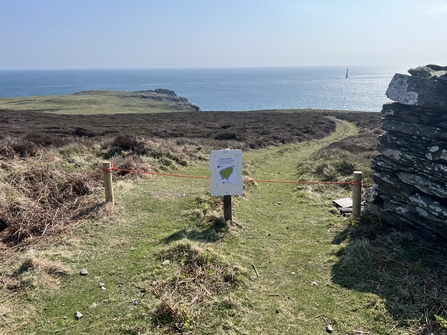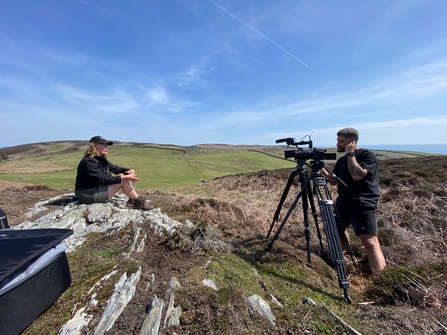The presumed same Great Skua returned for its 10th year on the 15th, with a third Peregrine being harassed by the resident pair. The first Ringed Plover of the year was at Cow on the 17th and a steady Hirundine passage totalled 103 Swallows and 19 Sand Martins. The year list hit 100 on the 18th with two Whitethroats and a Whinchat around the Observatory (both new for the year) with seven Rooks flying over also notable. The first Sedge Warbler was in the Withies on the 20th with a flyover Tree Pipit, four Whitethroats and a Grasshopper Warbler. The 21st had a Stock Dove, Collared Dove and Woodpigeon, with a White Wagtail, a Kestrel, a Goldcrest and a male Whinchat. The highlight of the 22nd was a pair of House Sparrows trapped in the Heligoland trap, with a further two Grasshopper Warblers also trapped. Two Turnstones and two White Wagtails were present on the 23rd, and the 24th had 109 Eiders, a female Whinchat, three Whitethroats and a Sedge Warbler. The 26th saw two firsts for the year: a Swift and a Lapwing. A singing Skylark was unusual and 127 Swallows, 11 House Martins, seven Sand Martins, a Fieldfare, five Sedge Warblers and six Whitethroats were logged. A Sandwich Tern and 97 Swallows headlined the 27th, with four Rook, a Skylark, 159 Swallows and eight House Martins on the 29th. The month ended with three 'year ticks' in the form of an Osprey drifting north, a Reed Warbler trapped at the Observatory and a calling Lesser Whitethroat in the Withies. Elsewhere, a female Whinchat, a Tree Pipit, a Goldcrest, seven Sedge Warblers, five Jackdaws, a Common Sandpiper and five Whimbrels were recorded.
Away from migrating birds, the first Eider nest was found on the 27th, Razorbills had started to lay, Black Guillemots were singing and Stonechats were busy feeding their chicks.
The team have made use of MWT's thermal drone to monitor and locate some nests hidden on the cliffs, and using our rope kit we safely reached a Raven nest on the steep slopes near the lighthouses to ring the chick - the first Raven to be ringed on the Calf since 2014! We have also been out surveying and ringing in our Shag colonies, having now ringed the most adult shags in a single year in Calf history. Following the return of the Manx Shearwaters, we have also spent nights patrolling the coasts and cliffs ringing these special birds. We have installed a burrow webcam through which you can now watch in real time as a pair of Shearwaters raise their chick. Head to the webcam page of the MWT website and check it out!

Calf breeding bird track signage © Kate Fox
Now that we are in the nesting season, several signs have been erected around the Calf labeling roped off areas and asking guests to stick to the marked pathways to protect our important ground-nesting birds. Several areas, such as Burroo Neck, Rarick, and Caigher, not to mention many others, have nationally important colonies of seabirds such as the enigmatic Manx Shearwater. If visiting the Calf over the coming months, please remain on the paths as unnecessary disturbances can threaten the reproductive success of these beautiful animals.
Our moth trapping efforts and butterfly transects have turned up some interesting specimens. Stunning moths such as the Gold Spot, Poplar Hawk-moth, Elephant Hawk-moth and Cinnabar moths have been turning up in increasing numbers. We have recorded the first Orange-tip butterfly since 2008, and species such as Small Coppers and Wall Brown butterflies are making more common appearances.
Vehicle maintenance and cleaning is a recurring battle on the Calf. The recent warm weather, whilst allowing the team to enjoy the crystal-clear (but rather cold) waters surrounding the Calf, also generates a lot of dust and grime that needs to be power washed off the vehicles (and staff members!). The vehicles have received attention towards their brakes, filters, and tyres.
The harbours also require constant maintenance from our Estate Team. Algae grows thick on the quays of South and Cow Harbour, needing constant vigilance to ensure that the harbours remain safe and functional in the event of emergency and throughout regular service. The residents of the Calf rely upon clear and safe harbours for regular food and supply drops, often involving using our recently erected crane (see our previous blog!), not to mention allowing for safe and sustainable tourism to the Calf.
At the end of the month, we welcomed a new band of volunteers into Calf life. Matt and Cathy, visiting from Australia, have joined the Estate team for the next three weeks. Rebecca, over from Scotland, and returning ringing volunteer Ann have joined the Ornithological team lending their hands and enthusiasm towards our ringing efforts and surveying breeding Eiders.

Kate being interviewed for a Visit IoM film © Lara Howe
We have also hosted a videographer from Visit Isle of Man, producing content on sustainable tourism for the Island, and a journalist from the BBC who was interested in writing a piece on Calf life. The stream of visitors to the Calf certainly brings new life into the observatory, ensuring that each new day continues to be as exciting as the last.












